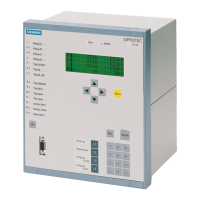2 Functions
58
7SD5 Manual
C53000-G1176-C169-1
index 0 (default setting). The relevant vector group index must be stated for the other
winding(s).
Example:
Transformer Yy6d5
For the Y end is set: VECTOR GROUP I = 0,
For the y end is set: VECTOR GROUP I = 6,
For the d end is set: VECTOR GROUP I = 5.
If a different winding is chosen as reference winding, e.g. the d winding, this has to be
taken into consideration:
For the Y end is set: VECTOR GROUP I = 7 (12 - 5),
For the y end is set: VECTOR GROUP I = 1 (6 - 5),
For the d end is set: VECTOR GROUP I = 0 (5 - 5 = 0 = reference side).
Address 1161 VECTOR GROUP U is normally set to the same value as address 1162
VECTOR GROUP I.
If the vector group of the transformer is adapted with external means, e.g. because
there are matching transformers in the measuring circuit that are still used, set
VECTOR GROUP I = 0 at all ends. In this case the differential protection operates
without proper matching computation. However, the measuring voltages transmitted
via the transformer would not be adapted in the device and therefore not be calculated
and displayed correctly. Address 1161 VECTOR GROUP U serves to remove this dis-
advantage. Set the correct vector group of the transformer according to the above-
mentioned considerations.
Address 1162 VECTOR GROUP I is therefore relevant for the differential protection,
whereas address 1161 VECTOR GROUP U serves as a basis for the computation of
measured voltages beyond the transformer.
Address 1163 TRANS STP IS is used to set whether the power transformer starpoint
facing the device is earthed or not. If the starpoint is earthed, the device will eliminate
the zero sequence current of the relevant side, since this zero sequence current may
cause a spurious tripping in case of an earth fault outside of the protected zone.
General Line Data
of the Distance Pro-
tection
The statements under this margin heading apply to cases where the distance protec-
tion has been configured as the main or as a backup protection of the differential pro-
tection function.
The settings of the line data in this case refers to the common data which is indepen-
dent of the actual distance protection grading.
The line angle (address 1105 Line Angle) may be derived from the line parameters.
The following applies:
where R
L
is being the resistance and X
L
the reactance of the protected feeder. The line
parameters may either apply to the entire line length, or be per unit of line length as
the quotient is independent of length. Furthermore it makes no difference if the quo-
tients are calculated with primary or secondary values.
The line angle is of major importance, e.g. for earth impedance matching according to
amount and angle or for compounding in overvoltage protection.
www . ElectricalPartManuals . com
